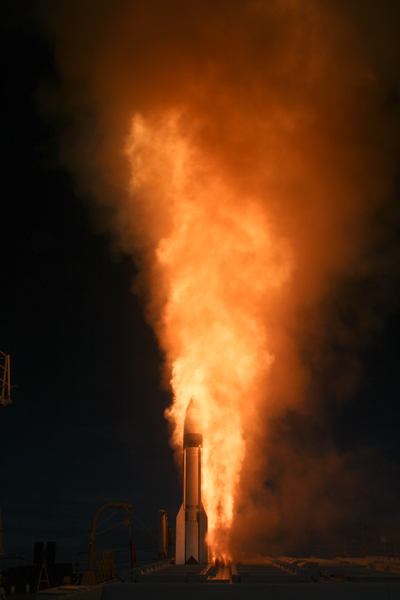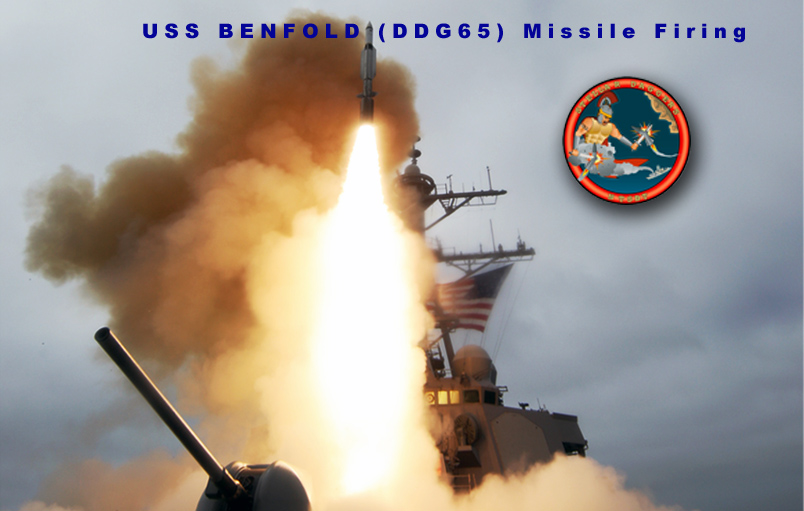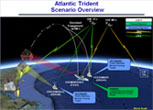Aegis Ballistic Missile Defense
Warfighter
"Operate Forward is our mandate — it's about being where it matters, when it matters.... When America needs a rapid response the Navy responds to the call.... For example, today we designate about ten Arleigh Burke-class destroyers deploying from Norfolk and Mayport to provide two in the Eastern Med for missile defense to our European allies. In a few years, we will cover the same mission with four destroyers based in Rota, Spain, and therefore free up six destroyers to deploy to other regions of the world."
Admiral Jonathan W. Greenert
Chief of Naval Operations
April 14, 2013
Transitioning Aegis BMD to the Navy
The Missile Defense Agency, Aegis BMD, and the Navy have made a serious commitment to "test as we fight," setting a standard for the Ballistic Missile Defense System (BMDS). Operational realism has been progressively inserted into every at-sea test.
Since the first launch of the SM-3 missile, Commander, Operational Test and Evaluation Force (COMOPTEVFOR), the Navy's independent operational test agency, has participated in flight test planning and execution, providing observation reports at the conclusion of each flight mission.
COMOPTEVFOR released his formal assessment of Aegis BMD operational testing in October 2008 stating "Aegis BMD 3.6 is operationally effective and operationally suitable" and "the tests executed a high degree of operational realism and testing rigor." The assessment recommended "the transition of 18 Aegis BMD ship sets and up to 90 SM-3 Block IA missiles from the Missile Defense Agency to the Navy." Aegis BMD is the first BMDS element to complete the entire MDA test process, from development through operational tests to transitioning to the Service.
Phased Adaptive Approach Phase I (Initial Integrated Defense)
Phase I is already underway. The Aegis BMD Weapon System BMD 3.6.X and the SM-3 Block IA missile are already deployed in the Fleet. In the first phase, Aegis BMD engagement capable warships are provided for the protection of southern Europe. The first deployment of European Phased Adaptive Approach capabilities came on March 7, 2011 when the guided missile cruiser USS Monterey deployed to Europe.
FTM-15
In April 2011, a critical European PAA Phase I milestone was achieved when Aegis BMD 3.6.1 / SM-3 Block IA missile destroyed an Intermediate Range Ballistic Missile (IRBM) target. During FTM-15, Aegis BMD exploited AN/TPY-2 radar track information passed to the ship via the Command and Control Battle Management and Communications (C2BMC) system to fire the SM-3 missile. FTM-15 demonstrated the ability of this Aegis BMD / AN/TPY-2 / C2BMC architecture to extend the ship battle space, winning back critical reaction time and enabling a longer range intercept. FTM-15, the foundation of integrated BMD, was the first Launch On Remote firing mission resulting in the first IRBM target intercept. Read more in the FTM-15 fact sheet.
FTO-01 (September 2013)
The MDA, BMDS Operational Test Agency, Joint Functional Component Command for Integrated Missile Defense and U.S. Pacific Command, in conjunction with Army soldiers from the Alpha Battery, 2nd Air Defense Artillery Regiment, Navy sailors aboard the Aegis BMD guided missile destroyer USS DECATUR (DDG 73) and Air Force airmen from the 613th Air and Operations Center successfully conducted a complex missile defense flight test, resulting in the intercept of two medium range ballistic missile targets. USS DECATUR with its Aegis BMD weapon system detected, tracked and successfully intercepted the target with an SM-3 Block IA guided missile.
Fleet Aegis BMD Exercises
As more Aegis BMD ships and missiles are being deployed to the Combatant Commanders, Fleet BMD tracking and firing exercises have been conducted.
Pacific Dragon
In a multinational ballistic missile tracking event, ships from Japan, South Korea and U.S. successfully tracked two near-simultaneous launched ballistic missile targets.
Atlantic Trident
In the first live, Naval-based Aegis BMD test held on the East Coast, USS Monterey (CG 61), USS Ramage (DDG 61) and USS Gonzalez (DDG 66) all successfully tracked the short-ranged ballistic missile target that was launched from NASA Wallops Island Flight Facility on 22 January 2011. Monterey and Ramage took turns tracking and conducting simulated engagements of the target that would have resulted in successful intercepts. Gonzalez participated by tracking the target.
Scenario Graphic |
Animation Video |
Pacific Blitz

Pacific Blitz was the first U.S. Navy proficiency firing to employ the SM-3 missile against a ballistic missile target. During the Fleet Exercise "Pacific Blitz", two Pearl Harbor-based Aegis BMD destroyers, USS Paul Hamilton (DDG 60) and USS Hopper (DDG 70) fired SM-3 missiles at separate targets. Upon detecting and tracking the target, USS Paul Hamilton launched an SM-3 missile resulting in a direct hit.
"Pacific Blitz highlights the successful transition from developmental test flights to operational fleet execution and demonstrates the viability of the Maritime BMD Concept of Operations."
Vice Admiral Samuel J. Locklear, USN
Commander, U.S. Third Fleet
November 1, 2008
Stellar Daggers
With the goal to create an operational test that can be exercised by the Fleet at various ranges available for BMD testing, Stellar Daggers was conducted at Point Mugu Test Center, Point Mugu, CA. During this event, USS Benfold (DDG 65) performed simultaneous engagements of a short-range ballistic missile target in the terminal phase of flight and a cruise missile target. Stellar Daggers was the final test of the Aegis BMD 3.6.1 Sea-Based Terminal capability.


